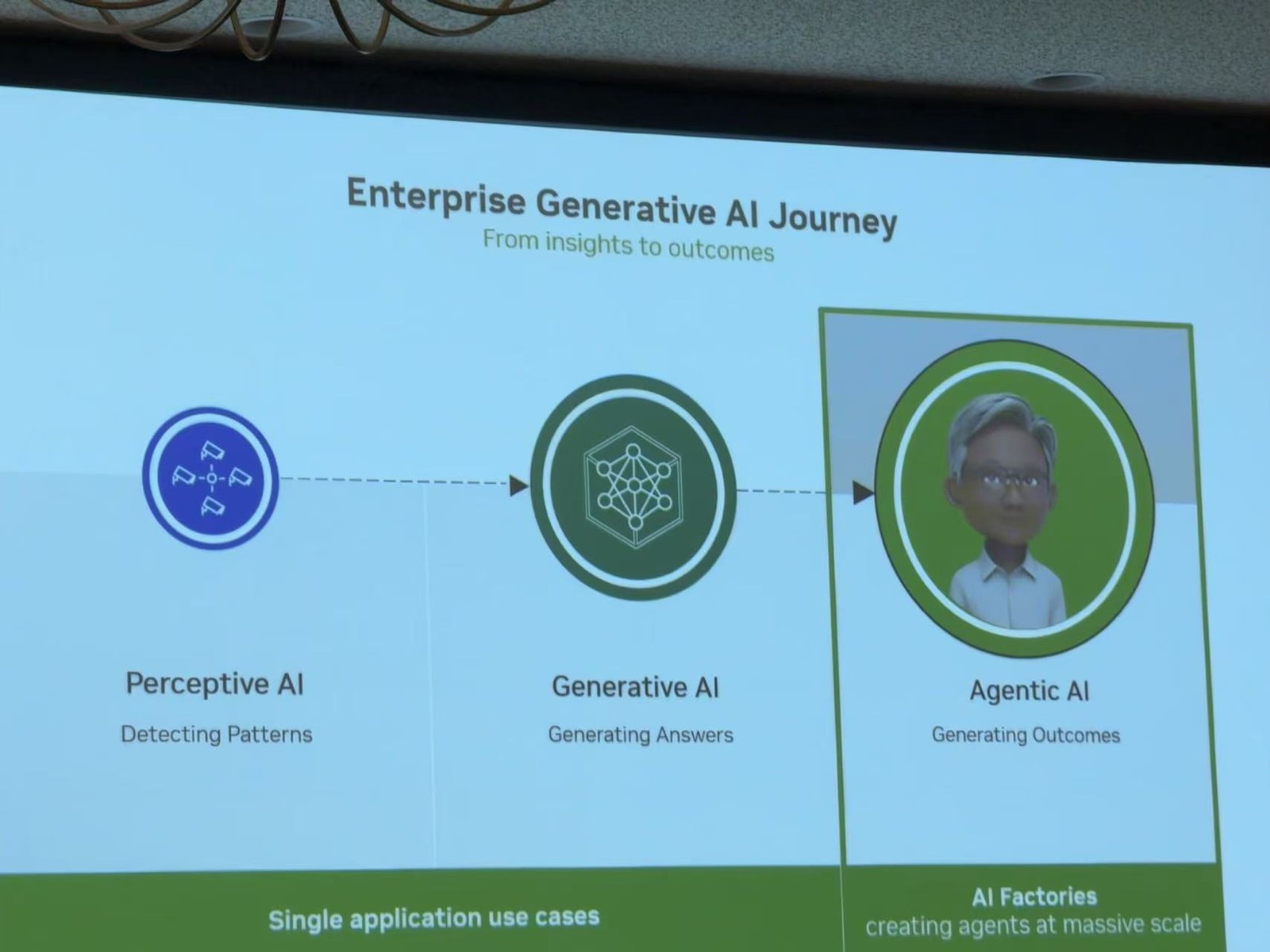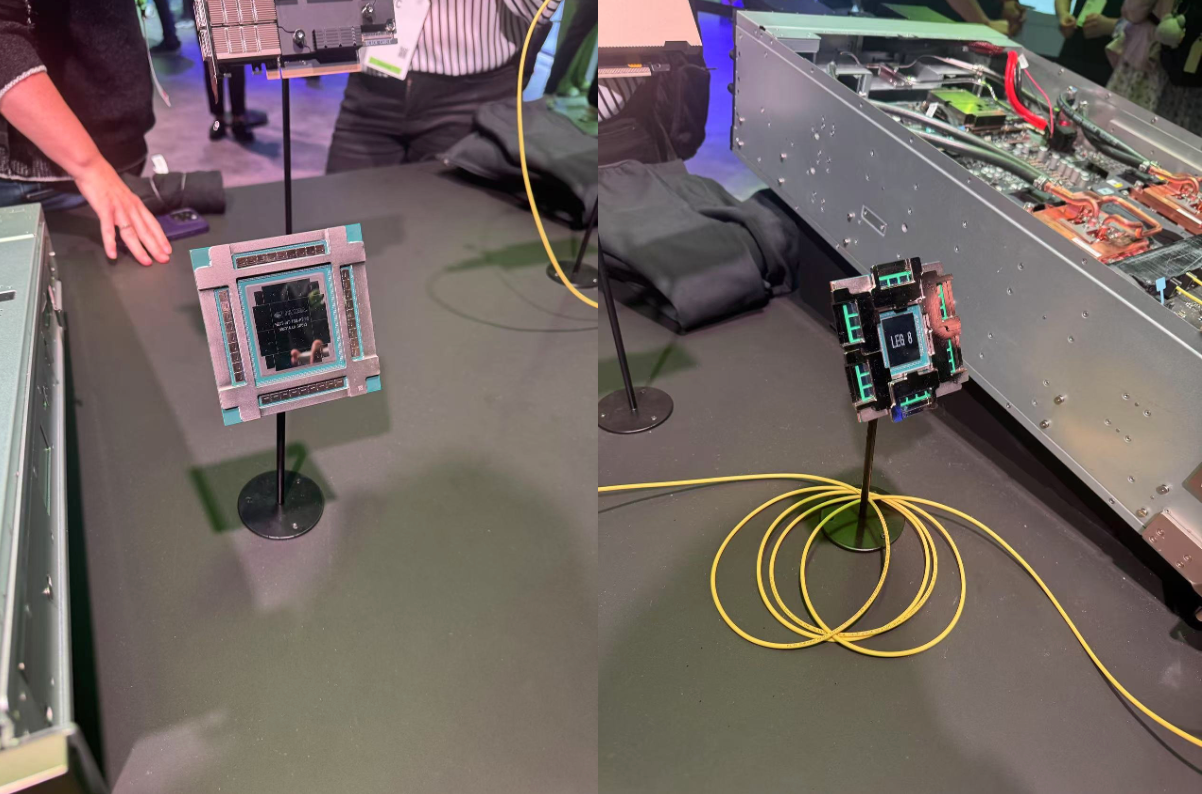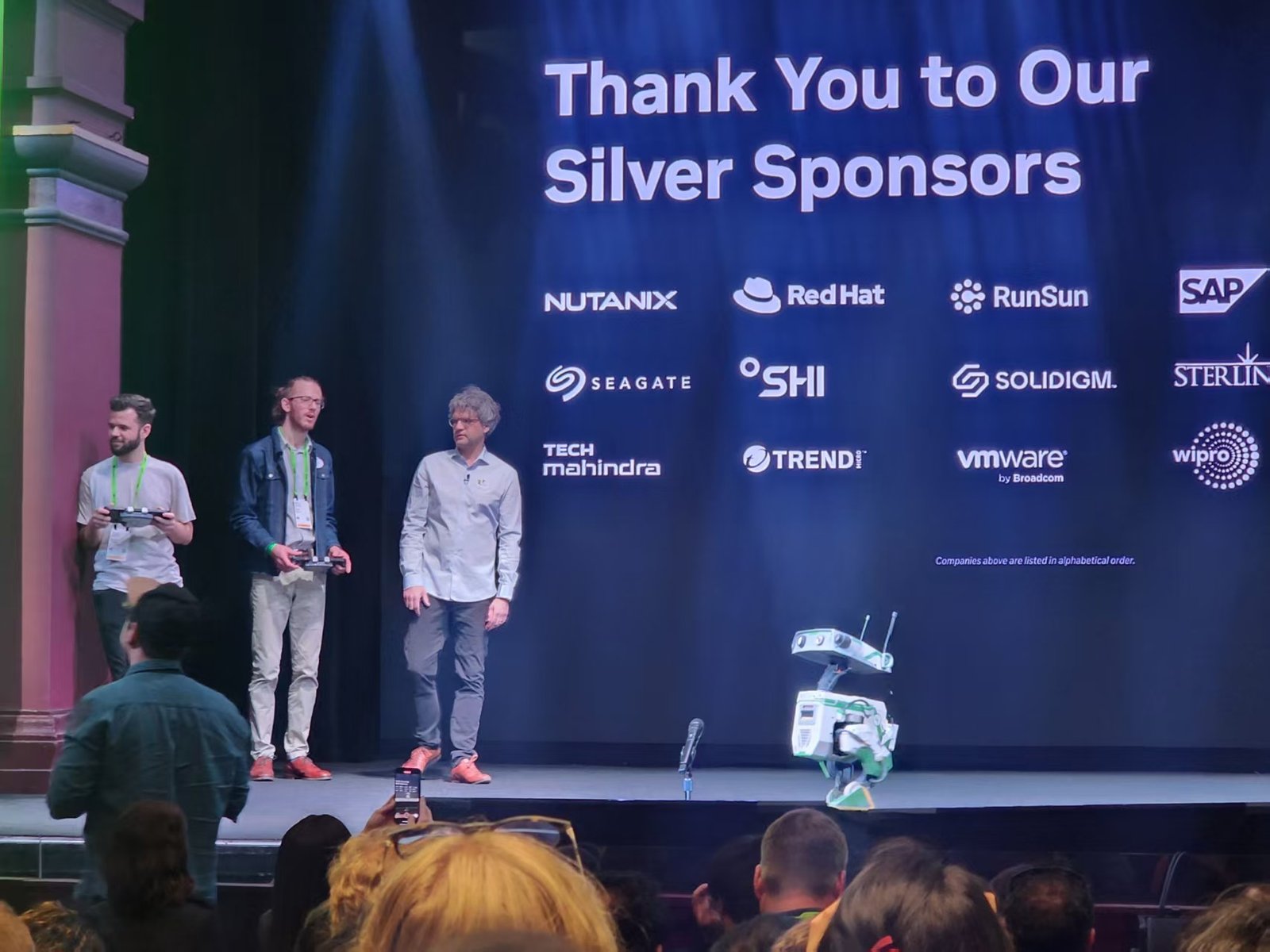 2025-04-03
2025-04-03
 0
0
GTC 2025 drew a significant crowd, with 25,000 in-person participants and 300,000 virtual attendees, marking a record high.
This year, GTC 2025 centered on "scale up" and "scale out," reflecting the industry's dual focus: enhancing the power of individual AI technologies and systems through vertical scaling ("scale up"), and broadening AI's reach by deploying interconnected systems horizontally ("scale out"). Beyond these core advancements, GTC 2025 also highlighted the broadening real-world applications of AI ("scale further out"), showcasing significant progress in how AI is changing and shaping the physical world.
First and Foremost: 3C’s First Global NVIDIA VC Alliance Experience!
See these happy people in the pic? We are proud to be the only VC from Hong Kong to take part in NVIDIA’s inaugural VC-Startup Speed Dating at GTC2025. Over the course of 3 hours, 10 select startups from around the world met with 10 global VCs for 10-minute pitch sessions, making it a productive 1,000 minutes of impactful discussions.
Its interesting to see what start ups Nvidia deem interesting, and its great when our own view coincides with NVIDIA’s. The energy was fantastic. We're absolutely thrilled to be recognized by NVIDIA for our AI and deep tech leadership, and we're excited to deepen our involvement with the VC Alliance and Inception Community. Onwards (or Outwards) and upwards!

Scaling Up: Making the existing system stronger
AI-Native Applications on Cloud Platforms: The Next Evolution
In the new AI era, cloud platforms are evolving beyond storage to offer GPU-as-a-Service, highlighting the critical role of AI-native applications that surpass traditional cloud-native architectures.
Leveraging NVIDIA's accelerated compute stack, new clouds prioritize scalability, flexibility, efficiency, and cost-effectiveness. Composable infrastructure, based on modularity, autonomy, orchestrability, and discoverability, simplifies scaling and management.
Infrastructure-as-Code (IaC) automates resource provisioning, allowing AI engineers to focus on business challenges and global deployments. NVIDIA's GPU innovations including the newly released Blackwell Ultra and Vera Rubin GPUs, software stack, and platforms like Vultr empower developers to simplify and scale AI workloads, including serverless functions.
Composable infrastructure and NVIDIA's technology support use cases like customer service agents, real-time IoT data processing, image analysis, and digital twins, driving tangible business outcomes.

Scaling Out: Adding more systems to work together
Agentic AI: The Next Frontier Powered by Reasoning
Agentic AI, where AI systems operate autonomously to achieve complex goals, is gaining traction. Model providers like OpenAI and Anthropic are building agentic functions, startups are creating agentic products, and cloud providers like Vultr are integrating agents. This signals a shift in the AI landscape.
As the conference positioned reasoning AI as crucial for truly intelligent systems, we believe that there will not be standalone generative LLMs. Instead, all new LLMs have to be equipped with reasoning capability for an Agentic AI future.
With this in mind, NVIDIA introduced Dyamo, an open-source inference framework, along with the Blackwell Ultra and Vera Rubin GPUs, and the AI-Q Blueprint for building intelligent agentic systems, demonstrating a holistic approach to AGI. We also spoke with Anthropic about their Model Context Protocol (MCP), which is evolving into an industry standard for multi-agent systems. The inclusion of Anthropic’s MCP into NVIDIA’s AgentQ further signifies a step towards a more mature and interconnected ecosystem.
Collaborations with Microsoft, SAP, Accenture, and Deloitte underscore the broad applicability and the market demand for these advanced AI capabilities.

Silicon Photonics: Powering the Next Generation of AI? An Investment Opportunity
GTC 2025 spotlighted silicon photonics as key to AI infrastructure, a development we have been closely monitoring. We are pleased to see this important progress. NVIDIA's Co-Packaged Optics (CPO) for InfiniBand and Ethernet enables unprecedented scalability and efficiency for AI factories.
CPO replaces traditional cables with light-based communication. By integrating Optical Engines (OEs) directly into the switch, NVIDIA's new Spectrum-X and Quantum-X switches achieve 1.6 Tb/s per port and 400 Tb/s aggregate bandwidth, enabling seamless collaboration across millions of GPUs. This translates to 3.5x better power efficiency and 10x greater network resilience. This allows AI data centers to scale and handle complex AI models.
NVIDIA is fostering an ecosystem with partners like TSMC and backing innovative startups. Companies like Lightmatter and Ayar Labs are pioneering Optical I/O (OIO). NVIDIA's endorsement solidifies silicon photonics as fundamental to the future of AI, positioning leading companies for growth.

Quantum Computing at GTC 2025: Bridging the Classical and Quantum Worlds
At GTC 2025, NVIDIA significantly increased its focus on quantum computing, announcing a research lab in Boston and the inaugural Quantum Day. Discussions emphasized the complementary role of accelerated computing (GPUs) in advancing quantum technology. While progress in quantum computing (double-digit logical qubits) was noted, challenges remain in scaling to the million-qubit regime.
NVIDIA's CUDA-Q and cuQuantum libraries, designed to accelerate quantum research and simulations, are key to hybrid quantum-classical workflows. NVIDIA's strategy focuses on leveraging its accelerated computing expertise to support the quantum ecosystem, rather than directly competing in quantum hardware.
Potential applications discussed at GTC 2025 include drug discovery, materials science, financial forecasting, and complex simulations. Hybrid quantum neural networks (HQNNs) for improved solar energy predictions were highlighted. Significant attention was given to quantum error correction and scalable hardware innovation.
While quantum computing is nascent, GTC 2025 indicated its potential to revolutionize fields, starting with fundamental science. NVIDIA's investment and focus on hybrid approaches position it to accelerate this revolution.

Scaling Further Out: Applying AI to new areas and making it more useful in the real world
Robotics Unleashed: The Dawn of Generalist Robots with GR00T N1
GTC 2025 unveiled NVIDIA Isaac GR00T N1: the first open, customizable foundation model for general humanoid reasoning. Its dual-system architecture (fast/slow thinking) enables GR00T N1 to generalize across common tasks such as grasping and manipulating objects, performing movements with one or both arms, and executing multi-step tasks requiring a combination of general skills.
To facilitate the development and training of robots based on this model, NVIDIA also introduced simulation frameworks and blueprints, including the NVIDIA Isaac GR00T Blueprint for synthetic data generation and the Newton physics engine, developed in collaboration with Google DeepMind and Disney Research. Early access granted to 1X Technologies, Agility Robotics, and Boston Dynamics, indicating strong industry interest and collaboration. GR00T N1 represents a significant stride towards enabling the creation of truly versatile, general-purpose humanoid robots capable of performing a wide array of tasks.
It's worth noting that China is rapidly emerging in robotics, driven by its market, practical focus and engineering strength. DJI, Unitree, DeepRobotics show strong capabilities. China's progress highlights the dynamic global landscape.

The Future of Personalized Bioengineering
Nobel laureate Dr. Arnold discussed advancements in protein engineering, crucial for tasks like personalized medicine and pollution reduction. Traditional directed evolution (randomly tweaking protein DNA and selecting the best) is slow and inefficient. AI is revolutionizing this process. Active Learning-Assisted Directed Evolution (ALDE) uses machine learning, alternating between wet-lab experiments and ML modeling to predict promising variants, dramatically improving efficiency. ALDE improved yield from 12% to 93%.
Much excitement surrounded Chroma, Dr. Grigoryan's "Protein design tool." Designing proteins from scratch is challenging due to combinatorial complexity (a 100-amino acid protein has ~20^100possible sequences) and the difficult structure-function relationship. Chroma uses diffusion models (like DALL·E) to generate new, functional protein structures and sequences. This programmability bakes constraints (symmetry, shape) into the generative process, eliminating post-hoc filtering. Chroma can design 1k+ residue proteins in minutes on a single GPU, showcasing promising scalability.
In short, we are one step closer to custom antibodies and personalised drugs. AI is building chassis for bioengineering and will impact all of us in a personalised way.
Summary
NVIDIA's GTC 2025 revealed a comprehensive strategy driving AI's rapid ascent, encompassing three key dimensions: scaling up to enhance individual technology capabilities vertically, scaling out to create interconnected intelligent systems horizontally, and scaling further out to broaden AI's application across diverse sectors in the physical world. This multifaceted approach was evident throughout the conference:
💡 Scale Up:GTC 2025 showcased advancements focused on enhancing vertical computing capabilities. powered by Blackwell Ultra, the rise of AI-native applications on the cloud leverages its global scalability, enabling diverse use cases and serverless deployment.
💡Scale Out: The conference emphasized the shift to Agentic AI, envisioning a future of multiple AI agents collaborating on complex tasks. NVIDIA is also focusing on tightly integrating photonics – networking technologies that transmit data using light – into accelerated computing infrastructure, a key component in enabling customers to scale out to ever larger systems. Furthermore, quantum computing is poised to unlock massive computational power, further enabling horizontal scaling.
💡Scale Further Out: GTC 2025 highlighted the expanding real-world applications of AI, including advancements in robotics (enhancing single robot capabilities) and bioengineering (improving directed evolution efficiency).
Increased presence from downstream users signals a shift in investment focus to application-layer AI solutions. One thing is clear - the conversation around AGI has evolved from "how" to "what to do with it," recognizing AI as a fundamental, unavoidable technology for any enterprise or individual.
Overall, GTC 2025 painted a picture of accelerated AI integration across sectors, driving innovation and transforming industries, with a trend towards application-focused investments and acceptance of AGI's inevitability, achieved through the acceleration of both scaling out of AI systems and scaling up of individual technologies.
###
Bonus - Partying with our portfolio company
Can we call it a pre-celebration? Cerebras announced their IPO plan two weeks after this party! 😎 😎





